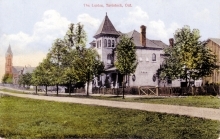Before 1903, postal cards and postcards had an "undivided" back, that is, one side of the card was reserved for the address only while the picture and message had to be on the other side. Then, in December 1903, one of the most important changes in Canadian postcard history occurred. The Official Postal Guide announced "The department has authorized...that a space may be reserved for communication on the face of the cards to the left of the address....This space must be marked off from the address section by a vertical line..." Thus was ushered in the Divided Back Period, also called the Golden Age of Postcards.
This “Divided Back Period” began in late 1903 and carried through to 1915 during World War 1. The rate for mailing these cards was a single penny. In some places there were mail deliveries multiple times a day. In an age before easy access to the telephone or travel by automobile, people could use the inexpensive and handy mail service to keep in touch with their families, friends, or neighbors the way we might use text messages today. In the US in 1908 alone, more than 677 million postcards were mailed.The postcard craze between 1907 and 1910 was particularly popular among rural and small-town women. Most of the postcards of Tavistock in our collection are postmarked around 1908-1910.
This postcard of the Lutheran Church parsonage is postmarked April 29, 1912 and was published by Rumsey and Company of Toronto and printed in Germany by the C. G. Roeder Company. The number 24118 in the stamp box on the address side means that the card was produced in 1911.
The set of postcards published by Rumsey and Co., Ltd., of Toronto printed in 1911 included a view of the centre of Tavistock from Woodstock Street North looking south, a view from the water tower of the east end of Tavistock, a view of Tavistock from the water tower looking north, a postcard of the “Linden” (the manse of Trinity Lutheran Church), another postcard of Trinity Lutheran Church in Sebastopol, and one of Zion EUB church.
